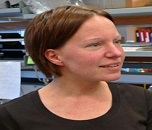
Alexandra Sobeck
University of Minnesota, USA
Title: Crosstalk between the Fanconi Anemia and ATRX/DAXX histone chaperone pathways promotes homologous recombination mechanisms in human cells
Biography
Biography: Alexandra Sobeck
Abstract
The Fanconi Anemia (FA) pathway functions to repair DNA interstand crosslinks (ICLs). During ICL repair, the central FANCD2 protein promotes the recruitment of downstream factors such as BRCA2[FANCD1] and RAD51[FANCR] that are crucial for homologous recombination (HR) repair of DNA double stranded breaks (reviewed in (1,2)). Previous studies from our laboratory and others showed that FANCD2 also promotes the HR-dependent recovery of hydroxyurea (HU) stalled replication forks (3-6). Intriguingly, we recently identified a new constitutive FANCD2 interactor named ATRX Alpha Thalassemia Retardation Syndrome X-linked). ATRX, in complex with DAXX (Death Domain-Associated Protein 6), acts as a histone H3.3 chaperone that plays key roles at repetitive DNA sequences, including replication fork recovery (7-10). Here, we investigated if FANCD2 and ATRX/DAXX functionally interact to promote the HR-dependent recovery of stalled replication forks, possibly in a histone chaperone-dependent manner.
To dissect cellular roles of FANCD2 and ATRX, we generated isogenic FANCD2-, ATRX- and FANCD2/ATRX-double deficient cell lines using CRISPR/Cas9 gene targeting techniques; moreover, we used siRNA-mediated DAXX knockdown. A dual labeling DNA fiber assay was used to analyze replication fork restart after hydroxyurea (HU)-triggered replication stress. To visualize the recruitment of HR factors to stalled replication forks, we performed immunostaining experiments in the absence/presence of HU.
We found that FANCD2 and ATRX cooperate to promote replication fork restart in concert with DAXX and the MRE11 nuclease. Moreover, we discovered that ATRX supports the FANCD2-dependent recruitment of key HR factors such as CtIP, BRCA2 and RAD51 to stalled replication forks. Importantly, our results also indicate that HR-mediated replication fork restart relies on histone chaperone activities of the FANCD2-ATRX/DAXX complex. Our study suggests that FANCD2 and the ATRX/DAXX complex are involved in chromatin remodeling/histone chaperone processes that take place in the vicinity of stalled replication forks to mediate HR-dependent fork repair.
